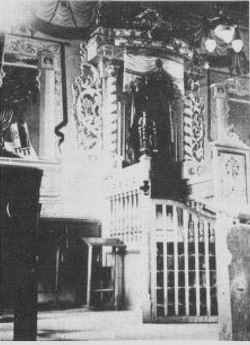 |
|
|
[Page 103]
(Svislach, Belarus)
53°02' 24°06'
By Shimon Finkelstein
(The Svislucz Memorial Book)
|
|
The town of Svislucz existed already in the fifteenth century, and was the property of a noble family named Fokush. During the 1700's, the town passed into the hands of other nobles – Krishpionov, and subsequently, in the 1800's it switched to become the property of the Grafs of the house of Tishkevich. At the entrance ways to the town, stone gates were erected, and at night the gates were locked, and no one entered or left.
As was the case in many Polish towns, there also were large fires in Svislucz, but after each blaze, the town was rebuilt anew. It is difficult to tell when Jews began to live in this town. What is known, is that according to the census of 1847, there were about a thousand Jews, and by 1897, the Jewish population had reached 2,086 people. On the eve of the First World War, there were approximately 3,500 Jews in the town.
On November 1942, the Nazis took out many Jews to the Vishvenik[1] Forest to be killed, while the young amongst them were transferred to Volkovysk, and from there to the extermination camps. The education of children occupied a revered place in the life of the Jewish community, and a large amount of effort and resources were dedicated to it. The first school was located in a building that had formerly served as a hospital. It was established by the Zionist activists in the town, and since this school took the place of the Heder system that had gone before, religious instruction occupied a recognizable part of its curriculum. There was also a kindergarten beside this school.
A Yiddish school was established in the early thirties, but very few of the Jewish children attended. Apart from this school, there was also a Polish public school in Svislucz. Only very few of the young Jewish students were accepted for study at the government Teacher's Seminary.
There were noted Rabbis who lived in this town, and among them were: Rabbi Gaon Meir Schatz the author of many books; the brilliant Torah scholar, Rabbi Moshe Zalman Rubinstein; The wise scribe, Rabbi Mordechai Salutsky; Aharon, the son of Rabbi Shneur Zalman Pines, who later became known at the Slobodka Yeshiva as the ‘Genius of Svislucz.’ Rabbi Mordechai-Dov Idelberg, the author of many books; Rabbi David Meisel, and others. The last of the Rabbis was Rabbi Gaon Chaim-Yaakov Mushinsky.
Heder classes were conducted in the homes of the teachers, and the Talmud Torah was in the same building as the Bet HaMedrash. A transition institution between the Heder and the Hebrew school was the ‘Reformed’ Heder, in which instruction was carried out in Hebrew. Among the first of the teachers in the Reformed Heder, was Lipa Sukenik, who later became known as Professor Sukenik at the Hebrew University in Jerusalem.[2]
[Page 104]
Among the cultural institutions of the town were two libraries: the first for Hebrew, and the second – for Yiddish books. All work at the libraries was voluntary. Among the many clubs, there was also a dramatic club.
Among the active youth movements, were HaShomer HaTza'ir, and Brit Trumpeldor [sic: Betar], that trained young people to achieve a Zionist fulfilment and make aliyah to the Holy Land. The HeHalutz branch also attracted a large number of young people.
Among the support institutions that provided local help and assistance, it is important to mention the Linat Tzedek, Providing for Brides, and the Free Loan Society, and others. Apart from these, there were other institutions of assistance at the hand of the Jewish community. The local fire-fighters organization was manned almost entirely by Jews, and it also filled roles involving self-defense.
There were three Batei Medrashim in the town, one of which was especially beautiful, and its walls were covered in art which was the work of an outstanding artist.
A vibrant and active life was characteristic of the Jewish community. Ideological discussions were held between members of different parties, but the common ground for all of them was – the longing for Zion, for aliyah, and forsaking the diaspora.
Like all towns, there was a market here to which all the peasants would stream from nearby villages, and the various streets would clog up from them. Many of the townsfolk made a living from working leather and from like factories. Also, the sawmill was an important source of income. Thick trees would be brought to the sawmill, and they were worked into wooden boards that were sent from Svislucz to the length and breadth of the land.
Svislucz served as a center for the Jews who lived in the nearby towns and villages, such as: Yalovka, Alibud, Mikholka, and others. After the Holocaust, no Jews remained in the town. Everything was destroyed, and only the Jewish cemetery remained. The town was rebuilt anew, but the population was entirely – Christian. It is found 14 km from the Polish border, and is today part of the Soviet Union.
Translator's footnotes:
|
|
JewishGen, Inc. makes no representations regarding the accuracy of
the translation. The reader may wish to refer to the original material
for verification.
JewishGen is not responsible for inaccuracies or omissions in the original work and cannot rewrite or edit the text to correct inaccuracies and/or omissions.
Our mission is to produce a translation of the original work and we cannot verify the accuracy of statements or alter facts cited.
 Vawkavysk, Belarus
Vawkavysk, Belarus
 Yizkor Book Project
Yizkor Book Project
 JewishGen Home Page
JewishGen Home Page
Copyright © 1999-2025 by JewishGen, Inc.
Updated 28 May 2024 by JH